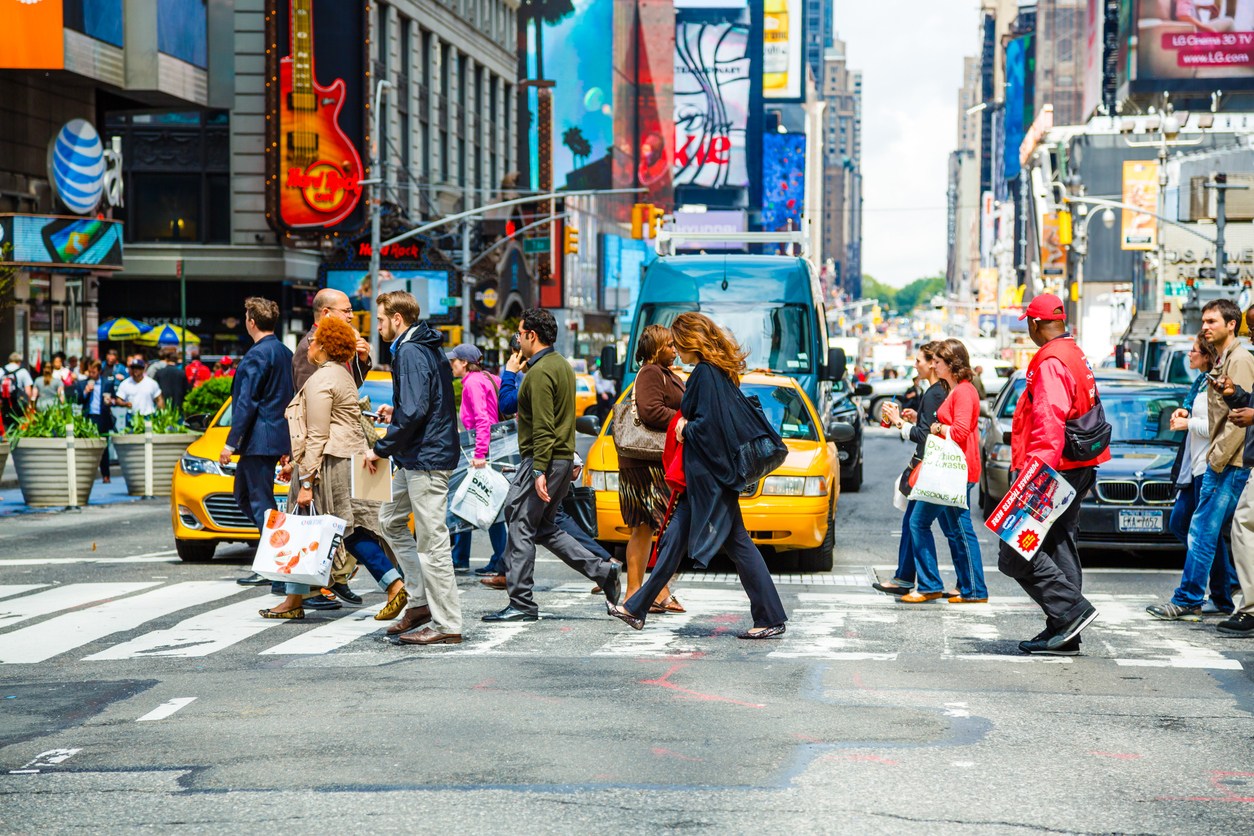Retail trends 2025: how businesses can stay ahead of the curve

Trends change faster than consumers scroll through TikToks. Knowing where consumer habits and preferences are headed can help you give your potential customers what they want before they even know they want it.
We’re going to look at what retail trends you can expect to see in 2025 so you can stay ahead of the curve and turn trends into sales.
The role of consumer behavior in retail trends
Consumer behavior has historically driven trends in the retail industry. Consumers’ buying habits have steadily changed over the past few decades — and it shows in the types of products they purchase and the companies they purchase from.
Let’s take a look at some of the trends that have been driving sales in recent years:
- Increased focus on sustainability – especially amongst Gen Z. According to research from Attest, over two-thirds of Gen Z consumers consider sustainability important when selecting beauty products, while over 70% prioritize it when choosing food products. It’s predicted that these figures will only increase as consumers get more eco-savvy about their retail choices.
- Greater demand for personalization. Consumers don’t want to feel like they’re just a number to a company; they desire customized content, such as discounts created just for them based on their buying behavior.
- More convenience and immediate satisfaction. Consumers are demanding same- or next-day delivery from online stores. In fact, according to Digital Commerce 360, 68% of shoppers will choose a business based on its speed of delivery.
- Influence of digital experiences on physical retail. Around two-thirds of surveyed US customers state that social media channels like Instagram and TikTok are the best way for brands to reach them, which means that digital platforms are a key tool for deepening relationships with customers.
What are the top retail trends for 2025?
Some of the top consumer retail trends for 2025 include:
- Sustainable and demand-driven retail
- Hybrid and tech-enhanced shopping experiences (blending physical and digital)
- Customer demand for transparent and efficient supply chains.
Let’s take a look at each of these — and more — in greater detail.
1. Demand-driven retail
Demand-driven retail is a business model where a company only produces items that are in demand. The objective is to meet customer needs without overstocking or overinvesting in a ‘fad.’ It’s supposed to be a win-win situation for businesses and consumers.
SHEIN, for example, has pioneered the demand-driven retail model we know today. Products are first produced in small-batch quantities to gauge consumer interest and then created as demand increases (or vice versa, if demand decreases). This also allows the fashion giant to gather data on consumer desires and react in real time to changing styles.
2. Hybrid retail experiences
Hybrid retail experiences blend online and in-store shopping. Online stores are more than just places for consumers to shop; they’re showrooms, distribution centers, and even entertainment venues. By incorporating omnichannel behaviors into operations, a physical store can improve its relationship with customers and boost sales.
Retailers can use augmented reality (AR) to create virtual simulations for consumers to interact with a product. For example, stores might offer virtual try-ons for clothes or design simulations to show how a piece of furniture might look in a specific space.
Consumer shopping trends indicate that these types of services are not only convenient but also profitable. The vast majority of brands that already use AR (86%) note that it helps to drive sales and attract new customers.
3. Sustainability as a necessity
Consumers are increasingly concerned about sustainability. According to a survey by Simon Kucher of 6,120 consumers across the US, Germany, UK, Australia, The Netherlands and India, people are increasingly prioritizing sustainability in the way they shop — with many consumers investigating businesses’ sustainability practices before they purchase.
And it’s not just consumers demanding better; environmental, social, and governance (ESG) practices are becoming more important than ever, with laws changing around the world. For example, some countries in Europe, like Switzerland, offer tax incentives, investment relief, and funding for sustainable businesses. On the flip side, they enforce carbon taxes on energy, transport, pollution and resources for those that don’t comply with ESG laws.
4. The impact of tech on retail
Tech, and particularly AI, has an immeasurable impact on retail industry trends. It can help businesses optimize stock levels, minimize waste and make the most of new trends and opportunities by anticipating customers’ needs.
Businesses like Walmart, Amazon and Nike are using AI to predict demand for their products, assess warehouse inventory levels, and personalize recommendations to customers.
Beyond marketing and stock management, in-store analytics are extremely useful. Insights drawn from heat maps and foot traffic data can help retailers optimize store layouts, making it easier to position key items at optimal points within the store.
5. Shifting supply chain strategies
Shifting economics and increasingly strict policies are driving enormous changes in supply chains. In the US, consumers say they’re willing to pay 10% more for products that have a smaller environmental impact, according to a survey conducted by Bain & Company.
Though this may get more complex in 2025 and beyond, as customers increasingly demand faster delivery of retail goods.
This is another place where AI can help. Companies can use the technology to increase efficiency and reduce their carbon footprints, thanks to better planning for production, inventory management, and distribution. Again, demand forecasting is pivotal in the way AI is transforming the supply chain industry.
6. Privacy concerns
Personalization is extremely useful for attracting and retaining customers, but it’s a data-heavy activity. With more public awareness around the dangers of sharing personal data, consumers are less and less inclined to click ‘Accept all’ on a cookie notice.
Think With Google estimates that 79% of consumers globally are now concerned with data privacy. And rightfully so: An IBM report listed the retail and wholesale industries as the fifth-most targeted by cybercriminals.
Beyond data breach dangers, personalisation might be falling out of fashion. Nearly half of consumers believe that hyper-personalization is creepy. On top of this, EY reports that trust in AI (which enables businesses to personalize content at scale) has slipped, making consumers more suspicious of tailored content.
7. Resurgence of brick and mortar stores
It might sound counterintuitive, especially following the “retail apocalypse” where brick and mortar stores were closing at an alarming rate due to the rise of ecommerce sites, but most Gen Z consumers prefer the in store experience.
In a survey of 1,000 consumers aged 18 to 26, 61% reported that they now prefer shopping in a physical store rather than online. This is attributed to the fact that Gen Z buyers feel they spend more wisely when shopping in-store (50%) and are uncomfortable with the amount of money they spend when shopping online (33%).
Plus, the Halo Effect means that physical stores actually tend to boost online sales.
8. Social commerce
The rise of social networks has contributed to changing the way consumers shop. Trends on these platforms drive users to purchase items they come across when exploring content or scrolling on their personalized feeds.
These platforms also give consumers the ability to investigate a brand and buy items without leaving the app. This is particularly important for younger buyers whose trust in a brand is heavily reliant on social proof.
In 2023, social commerce drove nearly $600 billion in revenue globally and this trend shows no sign of slowing. Projections show that the market will grow to surpass $1 trillion in 2028.
9. Multicultural marketing
As the awareness of consumer diversity increases, so do the demands of previously under-represented groups. This means that we’re likely to see a shift in what the retail sector offers and markets to these consumers in coming years.
Target’s Bring Home Support campaign is a great example of multicultural marketing in action. It emphasizes the retail giant’s focus not only on supporting minority-owned businesses but also local communities through the products they stock.
As with many other trends in the space, Gen Z is at the forefront of this retail landscape shift. PR Newswire research shows that multicultural communities significantly impact what these 12- to 27-year-olds purchase and what brands they prefer, particularly in:
- Food and restaurants
- Fashion
- Entertainment
- Beauty and wellness
- Household and cleaning
- Technology
How to leverage these trends in your retail strategy
You can use these trends in your retail strategy in a number of ways:
- Personalization. Many consumers expect a personalized experience throughout their buying journey. Sending emails with discounts for products a customer has previously browsed on your website or other platforms is a great way to do this.
- Meeting demand. Wants and needs are changing due to the increasingly diverse nature of consumers. In the retail world, this means offering tailored products to different groups. This leads to a more sustainable business model, too, as tracking and matching demand means you waste fewer materials when producing products. Also consider looking locally for supplies and materials to reduce transportation emissions.
- Creating omnichannel experiences. A loyalty program enables you to track customers across their interactions, from in-app to in-store, and give them specific discounts or rewards based on their purchasing history and habits.
- Investing in tech. Technology, particularly AI, can supercharge your sales efforts. Integrate it by using analytics to track past buying patterns and predict future consumer behavior.
How Attest can help you track retail trends
At Attest, we help businesses like yours understand your customers better. Your research with Attest gives you access to detailed and reliable insights that can help you drive business growth.
Analyze your audience to identify emerging retail trends and consumer preferences, then adapt your business strategies based on high-quality data. Get actionable insights, deepen your understanding of your target customers, and make decisions that put you ahead of your competitors.
Stay on top of the retail trends shaping the future
Consumer behavior is the number one driver of retail trends. As always, retail companies will need to stay ahead of the curve in 2025 if they want to improve their sales numbers.
It’s important to pay attention to consumer preferences like sustainability, personalization, and the desire for tech-powered shopping experiences — while also taking note of the increasing desire for privacy and data security.
Of course, not all consumers and markets have the same needs and desires. Use our market research tools to learn more about your target audience and what trends you can expect to see in the future.
Tell us what you think of this article by leaving a comment on LinkedIn.
Or share it on:
